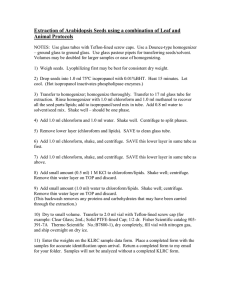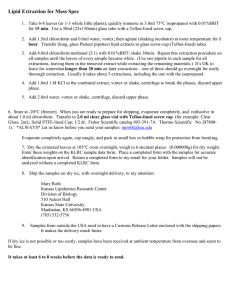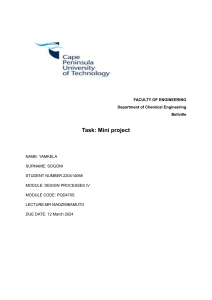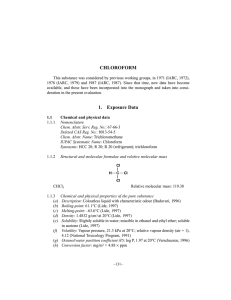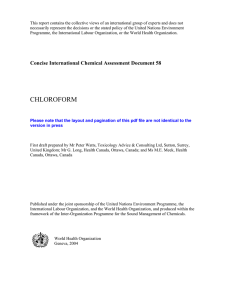Kansas LRC Protocols: Extraction of lipids from animal tissue
advertisement
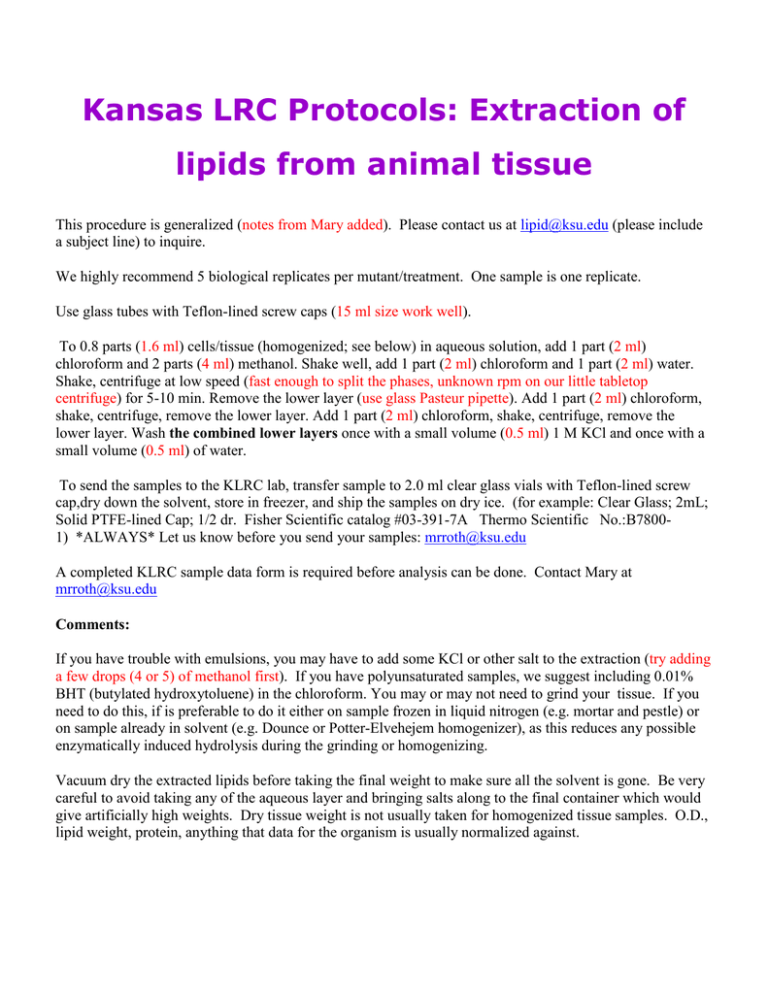
Kansas LRC Protocols: Extraction of lipids from animal tissue This procedure is generalized (notes from Mary added). Please contact us at lipid@ksu.edu (please include a subject line) to inquire. We highly recommend 5 biological replicates per mutant/treatment. One sample is one replicate. Use glass tubes with Teflon-lined screw caps (15 ml size work well). To 0.8 parts (1.6 ml) cells/tissue (homogenized; see below) in aqueous solution, add 1 part (2 ml) chloroform and 2 parts (4 ml) methanol. Shake well, add 1 part (2 ml) chloroform and 1 part (2 ml) water. Shake, centrifuge at low speed (fast enough to split the phases, unknown rpm on our little tabletop centrifuge) for 5-10 min. Remove the lower layer (use glass Pasteur pipette). Add 1 part (2 ml) chloroform, shake, centrifuge, remove the lower layer. Add 1 part (2 ml) chloroform, shake, centrifuge, remove the lower layer. Wash the combined lower layers once with a small volume (0.5 ml) 1 M KCl and once with a small volume (0.5 ml) of water. To send the samples to the KLRC lab, transfer sample to 2.0 ml clear glass vials with Teflon-lined screw cap,dry down the solvent, store in freezer, and ship the samples on dry ice. (for example: Clear Glass; 2mL; Solid PTFE-lined Cap; 1/2 dr. Fisher Scientific catalog #03-391-7A Thermo Scientific No.:B78001) *ALWAYS* Let us know before you send your samples: mrroth@ksu.edu A completed KLRC sample data form is required before analysis can be done. Contact Mary at mrroth@ksu.edu Comments: If you have trouble with emulsions, you may have to add some KCl or other salt to the extraction (try adding a few drops (4 or 5) of methanol first). If you have polyunsaturated samples, we suggest including 0.01% BHT (butylated hydroxytoluene) in the chloroform. You may or may not need to grind your tissue. If you need to do this, if is preferable to do it either on sample frozen in liquid nitrogen (e.g. mortar and pestle) or on sample already in solvent (e.g. Dounce or Potter-Elvehejem homogenizer), as this reduces any possible enzymatically induced hydrolysis during the grinding or homogenizing. Vacuum dry the extracted lipids before taking the final weight to make sure all the solvent is gone. Be very careful to avoid taking any of the aqueous layer and bringing salts along to the final container which would give artificially high weights. Dry tissue weight is not usually taken for homogenized tissue samples. O.D., lipid weight, protein, anything that data for the organism is usually normalized against. Enter the data for normalizing on the KLRC sample data form. Place a completed form with the samples for accurate identification upon arrival. Return a completed form to my email for your folder. Samples will not be analyzed without a completed KLRC form. Ship the samples on dry ice, with overnight delivery to: Mary Roth Kansas Lipidomics Research Center Division of Biology Kansas State University 510 Ackert Hall 1717 Claflin Road Manhattan, KS 66506-4901 USA (785) 532-5756 Samples from outside the USA need to have a Customs Release Letter enclosed with the shipping papers. It makes the delivery much faster. If dry ice is not possible or too costly, samples have been received at ambient temperature from overseas and seem to be fine. It takes at least 6 to 8 weeks before the data is ready to send.
